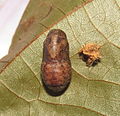| Angled Pierrot | |
|---|---|
 | |
| Scientific classification | |
| Kingdom: | Animalia |
| Phylum: | Arthropoda |
| Class: | Insecta |
| Order: | Lepidoptera |
| Family: | Lycaenidae |
| Genus: | Caleta |
| Species: | C. decidia |
| Binomial name | |
| Caleta decidia (Hewitson, 1876) | |
| Synonyms | |
| |
Caleta decidia, the angled Pierrot, [1] is a species of blue butterfly found in south Asia and southeast Asia. [2] [3] [4]




